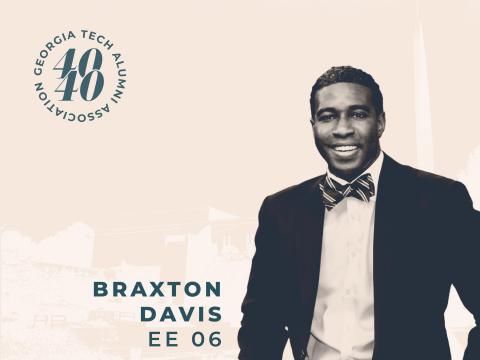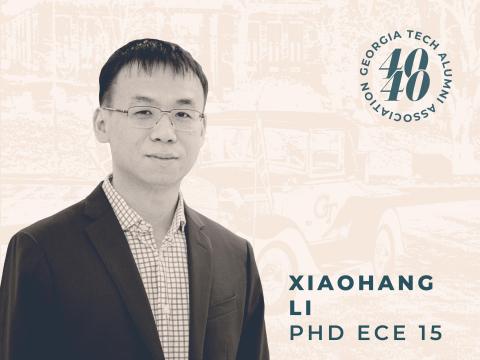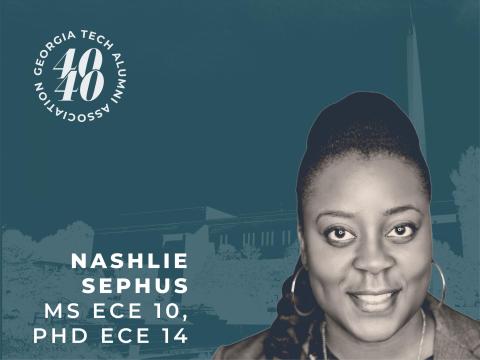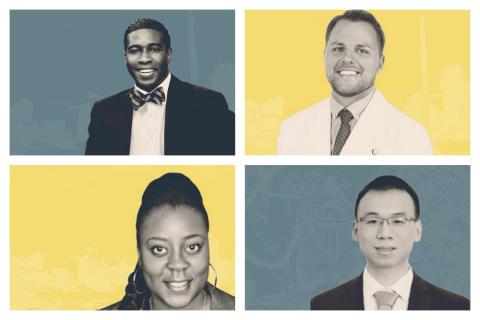At the beginning of the fall 2020 semester, the Georgia Tech Alumni Association announced honorees for its new program, 40 Under 40. The program celebrates distinguished alumni who have innovated industries and positively impacted communities across the globe. Out of 250 nominees, four alumni from the School of Electrical and Computer Engineering (ECE) have risen to the top and are included in the inaugural list.
Braxton Davis
After earning his bachelor’s degree in electrical engineering through the dual degree engineering program between Morehouse College and Georgia Tech, Braxton Davis (EE ‘06) went on to get his law degree from Georgia State University with a focus in intellectual property law. As an undergraduate student, Davis was aware that many electrical engineers go on to study law and become successful patent attorneys, but there was another, more personal reason he decided to go to law school.
Davis, who was born in Detroit, Michigan and grew up in Walterboro, South Carolina, was a victim of racial profiling by a police officer while he was enrolled at Georgia Tech. Finding himself handcuffed and detained for “impeding traffic” while standing on a sidewalk in Buckhead, he was eventually let off when the officer realized he was a Georgia Tech student.
“He basically let me off with a warning and said that if I messed up again, I’d be going to jail. The entire incident left me really upset and shaken, and I realized then and there that I needed to do as much as I can to protect myself and the best way to do that was knowing the law and knowing my rights,” said Davis.
Davis went on to become a successful patent attorney, but an ingrained entrepreneurial spirit meant he didn’t stop there. After leaving law school and feeling deficient in his education surrounding patent law, he was compelled to standardize the field for others with engineering backgrounds. In 2017, he established the National Council on Patent Practicum (NCPP), a non-profit which offers training for engineers and certification for patent attorneys. The training received through NCPP teaches practitioners what they need to know to practice patent law while creating a more quality patent ecosystem.
In addition to founding NCPP, Davis also launched a startup called Metric Mate. The company creates devices that make pin-based and plate-loaded exercise equipment smart by sending your data to your mobile phone. Tracking reps, rests, weights, and intensity allows people to work with a personal trainer remotely and gives health care workers the ability to monitor fitness in patients.
Davis says that his path from electrical engineer to patent attorney to inventor just makes sense in the context of being a Yellow Jacket. “Being well-rounded, driven, and innovative--that’s what Georgia Tech is all about,” said Davis.
Greg Kolovich
Necessity is the mother of invention, which is how Greg Kolovich (EE ’04) ended up creating a small, hand-held X-ray and digital camera that is disrupting the medical device industry in a really big way.
Kolovich, who went to medical school and became an orthopedic hand and micro-surgeon after receiving his bachelor’s degree from Georgia Tech, had a problem. His surgical specialty required quick, accurate X-rays to be taken on the fly and using the traditional heavy, tethered X-ray machine wasn’t cutting it.
With the help of fellow ECE alumnus Evan Ruff and the support of a Georgia Tech incubator called the Advanced Technology Development Center (ATDC), he created a solution—the Micro C device—and founded his company, OXOS Medical. The Micro C is a lightweight, portable X-ray device that provides infinite degrees of freedom and flexibility and is poised to completely change the face of medical imaging.
But before becoming a doctor, inventor, and entrepreneur, Kolovich came from humble roots in Cleveland, Ohio. Kolovich and his four siblings understood that if they wanted to attend college, they would have to pay their own way. A President's Scholarship made it possible for him to attend Georgia Tech and he came ready to work.
An electrical engineering degree appealed to him because of how versatile it was. “I started off wanting to work for NASA and thought I would study aerospace engineering, but then realized that NASA hires way more electrical engineers,” said Kolovich.
As a full-time undergraduate student, Kolovich hustled—at one point holding down four different jobs, including performing standup comedy and organ and tissue procurement.
“I was fortunate to get hooked up with company that did organ and tissue procurement, which is exactly what it sounds like. I was on call and would be sent out to hospitals and morgues to harvest organ and tissue from donors,” said Kolovich.
This rather unorthodox part-time job sparked his interested in medicine. During his junior year, he began taking prerequisites for medical school. Upon graduation from Georgia Tech, Kolovich went back to his home state and got his medical degree from The Ohio State University. His fellowship was completed at Harvard/Massachusetts General Hospital. In both cases, Kolovich states studying medicine was a “walk in the park” compared to the rigors of Georgia Tech.
What started out as a something he needed to make his job easier, has now grown into a multimillion-dollar company with a suite of products ready to debut in the market. Staying true to his roots, OXOS Medical employs a team of Georgia Tech graduates from a variety of engineering fields.
“I couldn’t have done this without my EE degree. And OXOS is the perfect culmination of Georgia Tech—biomedicine, mechanical engineering, electrical engineering, chemical engineering, and computer science—it’s all incorporated,” said Kolovich.
Xiaohang Li
Upon graduating with his doctorate degree Xiaohang Li (ECE Ph.D. ‘15) faced a wide array of choices for his future and found himself torn between four excellent options: academia, industry, consulting, and entrepreneurship. Ultimately, it was his love for adventure, teaching, and research that prompted him to accept a faculty position at King Abdullah University of Science and Technology (KAUST) in Thuwal, Saudi Arabia.
“I think I’m an explorer and I had never been to the Middle East. It was such a mysterious place to me and also the birthplace of the earliest civilization. That was one of the attractions in addition to KAUST’s rising reputation, for sure,” said Li.
And it only stands to reason that this globetrotter chose a career that moved him across the world and now bounces him between Atlanta, Thuwal, and his hometown Liuzhou, China. After all, it was his international connections and love of adventure that brought him to Georgia Tech in the first place.
Li received his B.S. in Applied Physics from Huazhong University of Science and Technology (HUST) in Wuhan, China. Undergraduate research experience helped him to establish an initial interest in studying semiconductors, LEDs, and lasers. His undergraduate research advisor James Zhou happened to be a graduate of Georgia Tech and this connection, plus his research interests, led him to set his sights on Georgia Tech as well. One huge draw was the opportunity to work under one of the world’s leading experts on semiconductor materials and devices, Russell Dupuis, the Steve W. Chaddick Endowed Chair in Electro-Optics and a Georgia Research Alliance Eminent Scholar in the School of ECE.
Today, Li’s research group of 20 graduate students and postdocs is working on a device that can produce UV light from a semiconductor. Their research is particularly applicable in this time of COVID-19 since UV light is highly effective for killing viruses. And there is a tremendous environmental benefit to using a semiconductor as the source for UV light. Traditional sources of UV light are based on mercury lamps which expose the environment to a heavy toxic metal that doesn’t easily decompose and endangers the food chain.
On top of strides in his research, Li is also enjoying the scenic and historic attractions he gets to visit in Saudi Arabia, which has a vast land area similar to Western Europe and a variety of landforms. He especially likes the Red Sea, the City of Jeddah, and the volcanic craters near KAUST.
“As a newcomer to the country, it’s always interesting to visit different places and learn their history,” said Li.
Nashlie Sephus
PartPic, the visual recognition technology startup company Nashlie Sephus (MS ECE ’10, PhD ECE ’14) co-founded, was featured at TechCrunch Disrupt in 2014. Two short years later, the company, which was part of the ATDC portfolio, was acquired by Amazon. Things moved at lightning speed after that. Within two days, Sephus and her team moved from a three-room office space in Technology Square’s Centergy Building to Amazon Web Services headquarters in Buckhead. What began as a small, scrappy startup became a technology entrepreneurship success story almost overnight. Four years on, she is an applied science manager for Amazon AI Web Services and has the expertise and resources to nurture side projects that allow her to give back to her local communities.
Sephus started The Bean Path in her hometown of Jackson, Mississippi, a little over two years ago. The non-profit organization provides technical advice and guidance to individuals and small businesses in the surrounding area. Initiatives include tech hours at local libraries, engineering and coding programs for youth, and scholarships and grants for students and community organizations.
In addition, Sephus recently purchased a 12-acre, mixed-use real estate space in downtown Jackson that she plans to turn into a technology district. The development will include a makerspace, housing lots, restaurants, and a family fun center.
“I see this as my contribution to my community. I now have the capital to scale and increase impact. I love having these branches that reach out in addition to my day job,” said Sephus.
Another “branch” that Sephus is helping to grow is K.I.T.T. – a makerspace for Black students and researchers near the Georgia Tech campus. The project is being bootstrapped by Sephus and a group of other Georgia Tech alumni, mostly from the School of ECE. The goal is for the space to be online and ready for visitors by the end of the year. She hopes the project will be an opportunity for her and other alumni to meaningfully engage with Georgia Tech students.
“Having these side projects is so much fun. This is the time to be alive. All of these dreams that I’ve had for such a long time all go back to my time at Georgia Tech and the opportunities that I was able to grow and nurture,” said Sephus.
Additional Images




